A B C D E F G H I J K L M N O P Q R S T U V W X Y Z
The following is an alphabetical list of commonly used picture framing terms and their meaning.
A
Acidic Browning (Ageing): Mount and backing boards that are made from wood pulp fibre have naturally occurring acids and lignins in them. These acidic substances can cause yellowing/browning of the artwork paper. Many mount boards are chemically treated to neutralise the acids in the boards, but cheaper boards may not be. The neutralised ph balanced boards will slow the acidic browning (ageing) process down, but to eliminate it completely it is often best to use a museum grade 100% cotton fibre mount board since cotton is naturally acid free. The same is true of the tapes used to attach artworks to the mount and backing boards. These should always be ph-neutral paper products or indeed cotton rag tape to prevent the same browning effect. Cheaper (acidic) tapes like masking tape or brown frame backing tapes should never be used for mounting.
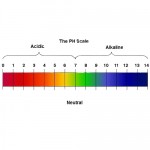
Acid-neutral (ph-neutral): Acidity is measured by the ph value of a material. The ph scale goes from 0 to 14, where 0 is highly acidic and 14 is highly alkaline. The wood from which mount board, cardboard and backing boards are made, is naturally acidic. Cheaper boards can still have this acidity in them. ph balanced (conservation) boards are chemically treated to reduce these acidic levels. However for ultimate acid protection for your artwork, cotton board has a stable ph value much closer to 7.
B
Backing Board (frame): A backing board is usually the term used to describe the final board used to enclose the back of the picture frame. Commonly a 2-3 mm hard brown board is used for this purpose. In times gone by this material was a thin solid wooden sheet, but now more commonly it is medium density fibreboard (MDF). This backing board should not be confused with the backing board for the picture mount which has to be acid free for artwork protection.
Backing Board (mount): A backing board in the mount will sit between the artwork and frame backing board. This is to protect the artwork and act as a buffer between it and the frame backing board which will likely be acidic. Mount backing boards should be acid neutral and can typically be conservation mount board or foam core board. Sometimes the backing boards (frame and mount) can be combined in a specialised product called Aqua board, which is only 2 mm thick, but combines an acid neutral white face on one side with a brown water resistant face on the reverse side. This type of product can be useful in frames where there is only a shallow rebate available.
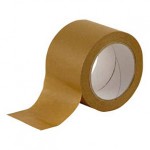
Backing Tapes (frame): Frame backing tapes are generally 38-75 mm wide brown tapes that are used to create a seal between the picture frame and the frame backing board in order to protect the frame contents from dust, humidity and temperature fluctuations. Frame backing tapes come in different grades of thickness and are available in self adhesive as well as gummed varieties.
Bevel: A bevel in framing is the term used to describe the 45o bevel that is cut into the picture mount in order to display the artwork. With white core mount board the bevel will be white in colour (most common), for black core mount board the bevel will be black in colour. Bevels are cut using a 45o angled blade on a mount cutter.
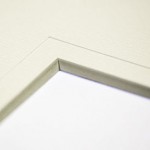
Bevel (deep): A deep bevel is the same as a bevel, but they are created using thicker (typically 2-3.5mm) mount boards which creates a deeper looking 45o bevel. The deep bevels are cut using a 45o angled blade on a mount cutter, but depending on the mount board thickness, sometimes longer mount cutter blades are required to do this.
Bevel (reverse): A reverse bevel is what you get if you cut a picture mount bevel the wrong way. Instead of a nice white 45o bevel viewed from the front of the picture mount, you will get no visible bevel and the 45o bevel is only visible from the back of the picture mount. If this happens, either you have been cutting from the front side of the mount board instead of the back side or you are cutting on the wrong edges on the back side. There is no real purpose for creating reverse bevel mounts.
Blade Depth (mount cutter): The blade depth relates to how deep the mount cutter blade cuts through the mount board and into the slip mat below. Ideally the mount cutter blade should go completely through the mount that you are trying to cut, but only just lightly score the surface of the slip mat. If it goes all the way down through the slip mat then the blade depth will likely need adjusted.
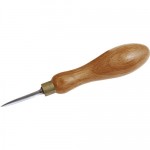
Bradawl: A bradawl is a commonly found tool in woodworking. It is like a screwdriver in shape, but has a pointed end. It is used for making an indentation in wood to ease the insertion of a screw, or nail. In picture framing it is mainly used for making indentations in the rear of the frame for the insertion of screws for attachment of D-Rings, screw eyes, hooks, or other picture frame fixings.
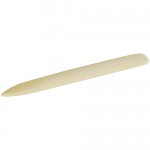
Burnishing Bone: A burnishing bone is a small white tool (traditionally made from bone) used in the framing industry. It is used for smoothing any rough edges caused by mount cutter blades (usually due to bluntness of the blade or the texture of the facing papers or condition of the slip mat). Burnishing bones will not cause the mount to become shiny where they are used. There are other metallic burnishing tools available.
C
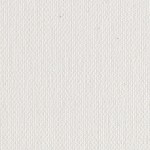
Canvas: Canvas materials have had many different uses for a long time. They have been used extensively in the art work. Originally for oil paintings and in more recent times for Acrylic paintings and more recently canvas prints. Canvas paintings (or prints) are usually stretched onto stretcher bars to make them flat for display/hanging purposes.
Canvas Frames: Most stretched canvases can be fitted into the rebate of regular picture frame. The rebate depth of the frame will dictate how much of the stretched canvas protrudes from the rear of the frame. You can get deeper rebate frames that will entirely cover the stretched canvas edges. Canvases can be fitted into frames by hardware such as Z-Clips, Offset Clamps (which come in different sizes) or spring retaining clips. Some canvases that have artwork painted on their sides will not require a frame to go around them, or they may be better suited to a float frame.
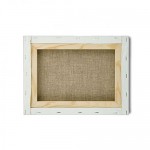
Canvas (stretched): Canvases for art are stretched onto a frame made from stretcher bars. They are often sold pre-stretched although the quite often the quality of the frames are sometimes poor typically with lightweight woods and cheaply assembled. Larger canvases usually require a centre cross beam in the frame to make sure the long edges don’t bow making the canvas appear slack. A well stretched canvas should be tight and sound a bit like a drum if you lightly tap it. The stretching itself is done usually with canvas stretching pliers, with the canvas being held onto the frame with many staples.
Conservation framing: A picture mount is meant to protect and preserve as well as to decorate and enhance the appearance of an artwork, photo or drawing. Unfortunately, a lot of mounting not only fails to meet this basic criteria, but can also increase damage to the artwork. Ageing of artwork can happen as a result of exposure to UV light, but more often it comes from acidic tapes, papers, mount board and backing board which leads to the characteristic ‘browning’ of artwork paper after a period of time. Conservation mounting is the process of using ph-balanced materials including tapes and mount board to provide protection to framed works of art on paper and preserving them from this ageing process.
D

D-Ring: These are small pieces of hardware that screw into the back of a frame (as a pair) and allow the attachment of cord or wire between them. They are usually made of steel, with a decorative nickel or brass plated finish, and are one of the most common ways to allow the hanging of a picture. D-Rings offer a more robust hanging solution than the lighter duty screw eyes or screw rings.
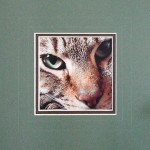
Double Mount: It is very common practice in picture framing to use more than one mount in a frame. If two mounts are used, then it is called a double mount. In this case, the inner mount can be a different colour and is used to enhance the appearance of an artwork’s colours. The double mount also acts as a method to draw the viewers eyes inwards towards the artwork. It can also be used in applications when thicker artwork such as textured acrylic or oil paints need to be spaced to prevent them from touching the glazing.
Dry Mounting: This refers to the sticking down (permanently) of an artwork to a self adhesive paper, board or foam board. The ‘Dry’ in dry mounting refers to the absence of messy wet adhesives. Dry mounting is usually done to flatten a large or unwieldy print or thin photographic paper to make it more rigid for display purposes or for framing. Large posters or photos can be prone to bubbling when dry mounted due to air pockets being trapped between the artwork and the self adhesive surface, so care has to be taken and application is usually done by using a roller to roll the artwork down onto the self adhesive surface. You should also consider whether such self adhesive board is archival quality (ph-neutral) or not. It may not matter for a cheap poster, but may matter for something more expensive or something you want to last. Most self adhesive boards are activated by the pressure of the roller. Other types of dry mounting include introduction of heat to activate an adhesive layer, and lend themselves to using a hot press. A hot press machine is used to heat a thin sheet of adhesive sandwiched between the art and the backing board, the hot press will also suck all the air out to stop any ripples appearing. Dry Mounting should only be used on photos, low cost prints and posters, it is not suitable for high value prints because it is almost impossible to reverse and could effect the re-sale value of the artwork.
Dust Cover: This is usually a brown paper seal on the back of a picture frame with adhesive on every edge to seal the frame from dust. It is commonly used in conservation framing. Every day framing usually just relies on brown backing tapes to do the same job.
E
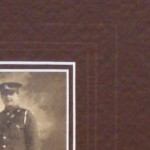
Embossing: This refers to the process of making a small indented pattern on the front face of the picture mount. This is achieved with an embossing tool, which is like a bradawl but with a balled head. This head when pressed and drawn like a pencil creates a subtle embossed line onto the mount board. The embossing tool should be used in conjunction with a straight edge (ruler or similar) and a measuring gauge. The main purpose of embossing a picture mount is for decoration as well as to add visual depth towards the subject matter.
F
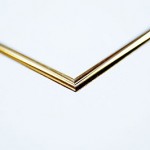
Fillet (slips): A fillet (or slip) is the name in the framing industry for a small piece of wooden or plastic moulding which fits either inside the rebate of a frame, or alternatively in between the picture mount and the artwork. Fillets tend to be slender, decorative mouldings with a raised decorative edge and flat lip behind. They sit inside the aperture of a mount providing a decorative lining and increasing the depth that artwork is held away from the glass. Their main use is purely decorative but they also tend to draw the viewers eye inwards towards the artwork. Fillets can also be used as a decorative spacer for textured artwork keeping it from contacting the glass. Slips are usually a flatter piece of wood or plastic with no rebate. They fit under the rebate of the main picture frame to create a decorative edge or to extend the inner edge of a frame behind which the mounted artwork or canvas sits. Fillets and slips require a high degree of accuracy when cutting so they fit the mount aperture or the frame rebate aperture exactly. Both can be permanently stuck into place with adhesive tape.
Fixings: This is the collective term for the hardware that is added on to a picture frame in order to hang it. This may include picture hangers, d-rings, screws etc.

Float Frame: This is an L shaped moulding cross section which is built into a frame into which a canvas is attached from the back. A small gap typically 6-12mm, is left between the canvas and the frame edge. The name derives from the appearance of the canvas to be floating inside frame.

Float Mount: This can be used to describe methods of making the mount feel like it is floating above the artwork. It give the perception of large amounts of 3D depth to the mount. It can be achieved by using foam board to space the distance between the first and second mounts. It is also possible to ‘float’ the image upwards too by mounting it on self adhesive foam board and making the mount bigger so it loos like the picture is floating all by itself in the 3D mount.
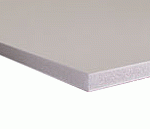
Foam Core Board (foam board): Foam core board is a widely used material in the framing industry and has many uses. It can be an excellent material for mounting an artwork to for display purposes. It can also act as an excellent barrier board between the artwork and a backing board. Foam boards have two paper faces with a foam core interior. The foam core commonly comes in 3mm and 5mm thickness and in white and black varieties. Foam core board can also come with an adhesive face for dry mounting an artwork (mainly posters and thinner photographic prints) to keep them flat and rigid. Higher quality foam board is available in acid neutral varieties. Foam board is a fairly rigid and durable material, and can also be used in the construction of 3d box frames.
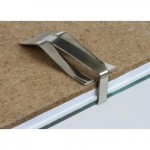
Frameless Picture (clip frame): Frameless picture frames are more commonly known as clip frames. They consist of a sandwich of glazing, mount board, artwork, mount backing board, brown backing board and are held together with clips around the edges of this sandwich. The clips can be simple sprung clips or the more secure Swiss clips which lock into holes made in the backing board.
Frame Size: The frame size in terms of a useful picture framing measurement relates to the size that you need to make the frame rebate (X by Y) to fit the picture mount that you have cut. Typically it is usual to add 3mm to each dimension of the mount size to find the required frame size. More than 3mm and the mount may be too small for the frame, less, and it may be too tight a fit. The term frame size to a customer may be entirely different though as they may want to know what size the external frame dimensions will be, this could be to see if they can fit the frame in a tight space on their wall, so it’s wise to understand the difference in this term when dealing with customers.

Framer’s Tabs: Tabs are the sharp, flat, shaped pieces of metal that are pushed into the side of the rebate to hold the backing board of a picture frame in place. They offer a more permanent fixing than turnbuttons. Framer’s tabs come in a variety of shapes, rectangular with a point, triangular, diamond etc, and they are either manually pushed in by the framer or more commonly fired in by a custom sprung ‘tab gun’. They are also available in flexible (for ease of later access to the frame contents) and semi rigid varieties.
G
Gesso: This is a glue-chalk primer which is typically applied to surfaces of a canvas in preparation for painting. Gesso dries hard and is available for purchase in art supply stores.
Giclée: This describes fine art digital prints made on any inkjet printers. The term is often used by artists, galleries, and print shops to denote high quality printing but it is unregulated and has no associated guarantee of quality. To produce quality Giclée prints, pigment based inks with light (UV) fastness should be used, but there is no guarantee of this by people producing Giclée prints.
Gilding: This is a term used to describe the application of gold leaf or gold paint or wax to a picture frame to give the appearance of a continuous layer of gold. Many gilding techniques have origins that are centuries old.
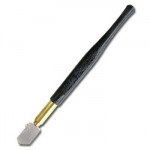
Glass Cutter: Glass cutters are used to cut glass down to the size required for fitting your frame. They are mainly hand tools, but can sometimes be found integrated into the head of a board/sheet/mount cutting system. Hand glass cutters require that you use a hard straight edge to run the glass cutter along to ensure you cut in a straight line. The glass cutter head is usually a small precision-ground carbide cutting (v-shaped) wheel. The best cutting technique involves lightly oiling the wheel before a cut, then cutting using a firm (but not excessive), uniform pressure over the whole cut. Once this is completed, the glass can then be broken along the score line by raising one end of the scored line slightly upwards whilst gently pressing down gently about 30mm either side of that line. The glass should break along the scored line. Practice makes perfect!

Glass Pliers (nipping pliers): Glass (nipping) pliers are available to aid with the glass cutting process. When a cut goes wrong sometimes you can get ragged edges, which can be ‘nipped’ of with glass nipping pliers, small pieces at a time. Glass pliers can also come with a head that aids with the breaking the glass along the cutter scored line if you don’t want to do it by hand.
Glazing (glass): The external transparent layer (glass or acrylic glass), that sits in front of the mount, artwork and backing. In most cases, it is 2mm ‘float’ glass. The purpose of glazing is to protect the artwork and mount from dust, humidity and temperature fluctuations. Other glazing options include anti reflective (stops glare) and UV filtering glazing for conservation framing.
H

Hangers (picture frame): this refers to a variety of picture frame fixings that are used to hang a picture. They can include D-Rings, Screw Eyes, Screw Rings, Strap Hangers, Heavy Duty Picture Hangers, Canvas Hangers, Photo Hangers, Gummed Cloth Hangers, Foam Board Hangers, Brass Bezel System Hangers, Saw Tooth Hangers, Triangular Hanger, Clip Over Hangers, Picture Plate Hangers, Key Rings, Slotted Hangers. Each have their own application and sometimes it even boils down to personal preference, but all are used to facilitate the hanging of pictures on a wall.

Hardwood: This refers to the hardness of the wooden mouldings. Woods naturally come in softer, medium and harder species. The most commonly used woods in picture framing include – soft woods: pine, redwood and cedar, Medium hardness woods : basswood, ramin, obeche and mahogany, Hardwoods: oak, walnut, cherry and ash. Hardwoods have strong grain patterns and are quite attractive in appearance. Dense hardwoods like oak can be a problematic to work with. Softwoods, on the other hand, are much lighter in weight, easier to work with but are more prone to warping.
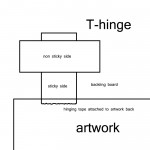
Hinging: This is the process of attaching an artwork to a picture mount or mount backing board using hinging tape. The tape is shaped into hinges and is attached along the top edge with minimal impact to the artwork. Some of the hinge types include T-Hinges and S-Hinges. When attached to the artwork and backing board, the resulting structure has the artwork hanging or ‘hinging’ by these tape hinges. Tapes used for hinging should always be acid free and designated for this purpose. Hinging should also take into account reversibility ie whether the hinge can be undone at a later stage with minimum effect to the artwork (ie tearing or marking).
Hot Press: A hot press machine is used in the Dry Mounting process. It is used to heat a sheet of thin adhesive (activating it) sandwiched between the art and the backing board, the machine will also suck all the air out to stop any ripples appearing.
I
No entries
J
No entries
K
No entries
L
No entries
M
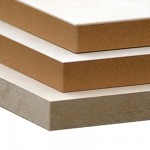
MDF: This refers to Medium Density Fibreboard, and is commonly used as a picture frame backing board in a thickness of either 2 or 3mm. It is a manufactured material that is made from compacted, bonded hard and soft wood fibres. MDF is quite cheap to but, but can be susceptible to warping out of shape when exposed to moisture. The 2mm boards warp quite easily in damp environments.
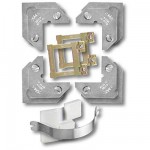
Metal Frame (aluminium frame): Metal frames are made from aluminium with a coloured finish. One of the benefits of metal is it very strong material for creating a narrow picture frame with. Aluminium frames are cut with an electric mitre saw with a special blade for aluminium. They are assembled and held together using right angled flat locking plates. Bow springs are used to hold the artwork, mounts, glazing and boards in place, and custom hangers have to be fitted in order to allow hanging. Metal frames are available as pre cut self assembly kits.

Mitre Guillotine (Miter Guillotine): To make a picture frame, the mouldings need to be cut to very accurate 45o angles (Mitres). The mitres can be achieved with a mitre saw, but with much more accuracy with a custom picture framing machine called a Mitre Guillotine. The guillotine which can be either foot or power operated, has two very sharp blades at perfect right angles to one another, and positioned at 45o to the long mouldings that are fed in. The blades will create a right and left 45o mitre with each cut, saving the picture framer time. Mitre guillotines usually have a long measuring arm with vernier scale(for accuracy) to the right and the mouldings are fed in from the left. Wider mouldings take more effort to cut and are usually cut by making the guillotine do progressive small nibble cuts until the cut is completed.
Mitre Joint (Miter Joint): To make a picture frame, the mouldings need to be cut accurately at 45o angles. These 45o mitres are then joined together by traditionally glue and nails, but more commonly these days by glue and V-nails.

Mitre Saw (Miter Saw): A mitre saw (both powered and hand versions) allow you to set the saw blade to cut at various angles. Most importantly for picture framing they can be set to an angle of +/-45o . You have to manually rotate the saw blade to to the left and right hand 45o mitres so this will be a slower process than that used with a mitre guillotine. Due to this speed limitation it is a method rarely used in a framing workshop, but it is more common to see mitre saws used by hobbyists. The saw blade has to be chosen correctly otherwise the mitres can have very rough surfaces which will not join together easily without some sanding or supplementary guillotining. It can also be a challenging process to get the opposite frame edges to be exactly the same size using this process. Some hard woods however are better suited to being sawed rather than guillotined eg. oak.
Mouldings: This is the term for the length of material (usually wood) used to make the actual picture frame. A plank of wood is just referred to as a plank until a routed channel (rebate) is cut along one edge, it can then officially be referred to as a moulding albeit a simple one! Mouldings can be bought from numerous picture framing suppliers in a wide variety of styles, finishes and colours. They are also available in bare wood which allows the picture framer some freedom to create a custom finish if desired. Mouldings are usually supplied in 3 metre lengths which can then be cut down as required for use by using mitre guillotines or mitre saws.
Mount Aperture (mount window): The mount aperture is the size of the bevelled hole that you want to open in the mount board to display your artwork. This aperture will be slightly smaller than your artwork dimensions in order to crop your artwork so you don’t see any unfinished or white edges.
Mount Multi Aperture (multiple mount windows): A multi-aperture picture mount is a mount that has multiple openings to accommodate more than one picture in the same mount (and ultimately in the same picture frame). It can be used to group similarly themed photographs or pieces of artwork together. Openings can also be made (if desired) to place titles into the mount which can describe the content. A multi-aperture mount can be created using even the most basic of mount cutter systems.
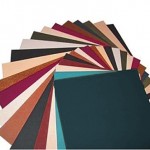
Mount Board: A wood pulp or cotton based board that is used to cut out a bevelled picture mount from These boards come in different grades, thickness (1.4, 2.0, 3.5mm) and colours (both facing paper and sometimes core) but are most commonly white cored. Types of mount board include-
- Budget mount board : cheap, but most likely not acid neutral, will have a core that ages (browns) quickly, and is not recommended for works that need to be preserved.
- Standard white core mount board : these boards have a core that will stay white. They likely will have had some treatment to neutralise acid in them, but they fall short of the standards used in conservation framing.
- Coloured core mount board : most commonly available with a black core, these boards may not be conservation grade level, but this will vary by manufacturer.
- Conservation mount board : These boards have a neutralised wood pulp core with acid free paper faces. These boards will be almost as good as cotton rag boards.
- Museum mount board : these boards are made from 100% cotton fibres. Cotton is a naturally acid free substance. These boards will only be available in a limited colour selection, and are used for the highest standards of conservation framing.
- Unbuffered museum board
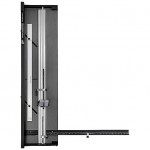
Mount Cutter: A mount cutter is a specialised picture framing tool that cuts a 45o bevel in the picture mount, they can also be used for cutting down the size of mount board. They vary in size from small hand held cutters to larger and more complex cutters with ruled squaring arms, production stops and integrated cutting heads. The mount cutter heads hold the blades that are used for cutting boards down and cutting 45o bevels. Keeping these blades sharp is essential, so they will need to be replaced frequently. Mount cutters are mainly flat board systems that require a large surface area to operate, but there are also some space saving vertical systems on the market. At the expensive end of the market are computer controlled mount cutter systems, which can produce very elaborate mount designs.
Mount Decoration: A picture mount can be made more aesthetically pleasing by adding some decoration to it. Decoration techniques include thin mount decoration tape, embossing tools, freehand bevel cutters, and V-grooves.
Mount Size: The mount size refers to the total height and width of a picture mount.

Mounting Tapes (picture): Picture mounting tapes are the tapes used to attach the artwork or photograph to the mount or mount backing board. These tapes should be acid neutral (ph-neutral) to avoid acidic browning of the artwork over time. The tapes are are also used to attach (hinge) the front mount to the mount backing board. Conservation framing principles have to be kept in mind when choosing a mounting tape. They come in self adhesive and gummed varieties and are available as acid neutral paper or cotton rag varieties.
N
No entries
O
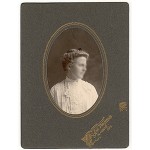
Oval mount (oval cutter): Oval and circular mounts require a specialised mount cutter hand tool called an oval cutter. Oval mounts are sometimes used with old black and white or sepia toned portraits to give an old world look, and many old photographs were traditionally set in oval mounts. The oval mount tends to focus the viewer’s attention on the centre of the picture, so they are useful for creating mounts for portraits. It is also most commonly used in the portrait format (rather than landscape).
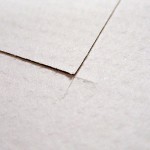
Over-cuts: This term relates to over run cuts in the mount bevel corners. As a result the centre of the mount will drop out, but depending on how large the over-cuts are the mount may end up looking highly unprofessional! You can’t remove over-cuts, but you can try to smooth them a bit with a burnishing bone. They usually are a result of having inaccurate offset calculations in a mount cutter rulers. These offsets can arise due to inconsistent mount board thickness, mount cutter blade or head movement. The opposite of over-cuts is under-cuts.
P
Plexiglass: One of many trade names for plastic (acrylic) glazing. Usually comes with a thin plastic film cover on either side protecting each face. The film pulls off to reveal the shiny Plexiglass surface. Commonly only 1.5mm thick, this type of glazing is still more resistant to breaking than regular glass so it can suit large frames (poster size) especially if they are to be hung in public halls or even children’s rooms etc. where safety is a concern. Its also a good glazing option if you are going to ship the frame anywhere. The downsides to plastic glazing are the static electricity it generates which can attract dust quite easily (which can be hard to remove again), and it is also very easy to mark (scratch).
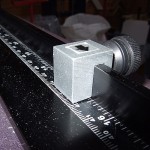
Production stop: A production stop is actually a screw in stop to the squaring arm ruler on a mount cutter system. They can also be found on vertical rulers on the mount cutter head area to set start and stop cut points. The aim of the stops are to speed up production and throughput when creating a higher quantity of mounts of a similar size and aperture, although they are often used when cutting single mounts too.
Q
No entries
R
Ragboard: This is the name that describes 100% cotton based mount board. Ragboard is naturally ph-neutral, and very durable so they are used for museum/conservation mounting applications. It is the only option when striving to achieve the highest level of conservation framing.
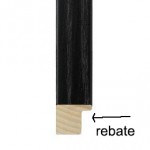
Rebate (or rabbet): The inner cut out ‘lip’ of a frame (moulding) in which the glass, mount, artwork, and backing are held into the frame by. Rebates are quantified by width and depth sizes. Generally, the rebate width commonly measures between 5-6mm, but the rebate depth varies the most from moulding to moulding. The depth of a rebate will govern how many layers in the frame that you can accommodate. eg. a rebate depth of 7 mm would accommodate 2 mm glazing, 2 mm backing board, 1.4 mm front mount and 1.4 mm back mount (total = 6.8 mm), but would not accommodate say a double mount which would add another 1.4 mm to the total making it too thick for the 7mm rebate depth of that frame.
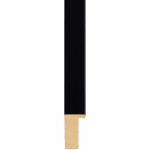
Rebate (deep): Deep rebate mouldings are mouldings which are quite often narrow but have a deeper than normal rebate of 25mm or more. They are designed to accommodate deep artwork like canvases and 3D shadow box frames eg. for framing sports shirts, or floating mounts etc. There tend to be fewer mouldings available with deep rebates than there are for the more standard sized rebates. Some deep rebate mouldings also have optional rebate spacers that match the moulding colour so that they can be used in conjunction with the moulding to easily create a 3D box frame.
Reversible mounting: In conservation and museum grade framing, this term relates to the reversibility of the preservation methods used to create that mount or frame. This ensures that any archival process can be undone and the artwork removed safely at a future date.
S
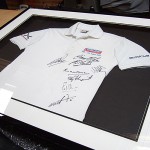
Shadow Box frame (3D box frame): This is a framing technique in which three dimensional objects are framed. This is done by creating a 3d type box behind the frame which can be hidden (although not always) by a front sitting mount. This box can allow the framing of 3d objects like golf balls, sports shirts, medals, and cricket bats etc. You can create box frame using standard mouldings, but deep rebate mouldings are quite commonly used for this purpose.
Slip mat: A slip mat is the term for a piece of mount board (usually an offcut) that always has to be placed behind a picture mount before you proceed to cut a 45o bevel. The mount cutter blade should go all the way through the picture mount board and lightly score the slip mat below without going completely through it to produce the best cut. If you don’t use a slip mat, you will likely get very ragged edges to the mount bevels and you could also damage your mount cutter too.
Slips (fillets): See fillets
Softwood: This refers to the hardness of the wooden mouldings. Woods naturally come in softer, medium and harder species. The most commonly used woods in picture framing include – soft woods: pine, redwood and cedar. Medium hardness woods : basswood, ramin, obeche and mahogany. Hardwoods: oak, walnut, cherry and ash.
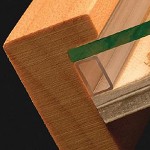
Spacer (rebate spacer): A spacer is a small plastic or wooden strip which is placed between the artwork and the glass (to space it from the glass) but hidden under the frame’s rebate. Spacers can also be used when no mount is required but where glazing is. They can also be used for framing textured art allowing enough space to glaze the frame.
Squaring arm: A squaring arm refers to the right angled arm that attaches to the less budget end mount cutters. It is there to make sure you feed large mount boards through at 90o to the mount cutter heads to make sure your mounts are squared.
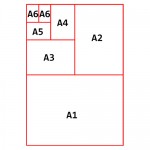
Standard Sizes: This can refer to standard sized papers or standard sized frames. Common standard paper sizes include :
Metric: A0, A1, A2, A3, A4, A5, A6 etc.
Imperial(US): “Letter”, “legal”, “ledger”, and “tabloid”
Common standard frame sizes (meaning they are available pre assembled) include:
Metric: A0, A1, A2, A3, A4, A5, A6
Imperial: 4×5″, 4×6″, 5×7″, 6×8″, 8×10″, 8×12″, 11×14″, 8-1/2×11″, 9×12″, 10×12″, 10×13″, 12×16″, 14×18″, 16×20″, 20×24″, 22×28″, 24×30″, 24×36″, 30×40″

Straight Edge: The term straight edge just refers to a true straight edged tool like a steel ruler or alternatively a free standing mount cutter ruler. In picture framing, it is very desirable to have a true straight edge reference as mounts should really always have perfectly straight edges. Sometimes it is essential to do a manual thin trim off a mount with a sharp blade, and this is best done using a steel rule for guidance. The blade will not cut into the steel ruler.

Strap Clamp (band clamp): A special type of clamp that allows you to clamp 4 mitred corners together tightly. It consists of a metal band or strap with four right angled corner blocks. The band is expandable to accommodate different frame sizes. It usually has two handles, one for locking the strap in place and one for tightening the whole loop. It is commonly used in hobbyist framing circles and other more general woodworking applications. Framing shops just use underpinners and their inbuilt vices instead as the strap clamp can be a bit unwieldy and cumbersome to deal with at times.
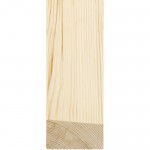
Stretcher Bars: This refers to the stretching frame that is used specifically for stretching a canvas print or paining on to. The stretcher bars come in long (usually 3 metre) lengths like most mouldings, but they are bare wood, and have no rebate They have a slightly sloping profile so that the stretched canvas only touches the outer edge of the stretcher bar on the front face of the canvas, this means that the frame won’t show through to the front side of the canvas after stretching. The stretcher frame is chopped and joined identically to any other frame.
T
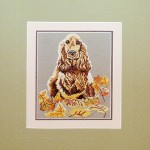
Triple Mount: A mounting method in which three mounts are used for depth perception and artistic design. Designed to draw the viewers eye into the artwork. The triple mount is created much the same way as a double mount, but by adding an extra step (third mount board and cut) to the process. In this image we have a triple mount helping to space the artwork (in this case a cross stitch) away from the glazing.
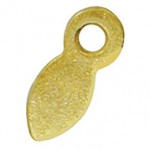
Turnbuttons: These are small, decorative, flat pieces of plated steel with a screw hole that are used to attach to the back of a picture frame holding the backing board in place. They can be rotated around for easy removal of the backing board and quick access to the mount and artwork. They are used in frames that will have their picture frequently changed. They come in a variety of finishes.
U

Under-cuts: This term relates to incomplete cuts in the mount bevel corners. As a result the centre of the mount likely will not drop out completely after being cut. You can take care of undercuts by manual intervention with a 45o angled blade. Under-cuts arise from having inaccurate offset calculations in your mount cutter rulers. These offsets can arise due to inconsistent mount board thickness, mount cutter blade or head movement. The opposite of undercuts is over-cuts.
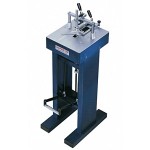
Underpinner: This term refers to a custom picture framing machine that is used to join mitre cut mouldings together to form a picture frame. The machine fires custom V-Nails of different sizes upwards into the underside of the mitred mouldings to create the joint. Each type of moulding will take a different size of V-Nail. Underpinners can be foot or power operated units.
V

V-Groove: A V-shaped incision in the surface of a mount board that reveals the (usually white) core and acts as a decorative border. V-grooves are usually cut with a specialised V-Groove mount cutter head. When cutting a V-groove into a mount board, you may cut the V in too deep and end up cuttin through the entire mount board. This happens most often with a standard 1.4mm thickness mount board, so V-grooves are more suited to thicker mount boards of 2mm or more.
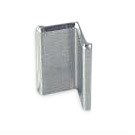
V-Nail: A V-shaped piece of hardened steel used for joining frame corner mitres together. V-Nails have largely replaced standard picture framing pins that were traditionally used. They are used in conjunction with a suitable glue to make the frame rigid at the corners. V-Nails are usually applied with specialised framing underpinners but can also be used by some hand tools too. The V-Nails are sharp on one edge (which helps to ease them into the frame) and dull on the other side (to allow a flatish surface to push against). They come in different depths (5, 7, 10, 12, 15mm) and can also sometimes be stacked on top of each another to achieve in between depths. They make the most sturdy joint when they are pushed up somewhere between 2/3 to 3/4 of the moulding thickness, although care needs to be made not to go further or the V-nails risk poking through the front face of the moulding rendering the moulding useless.
W X Y Z
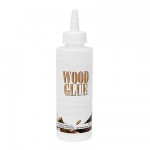
Wood glue: In order to create a robust picture frame corner, it is vital to use a suitable adhesive as well as using V-Nails or pins. The most common wood glue used is PVA based adhesive which is commonly available.
